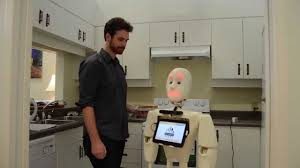Assistive Robots

Assistive Robot
Remember a time not so long ago when the idea of owning a personal computer seemed like a curiosity. The same may be so today with personal assistive robots. Millions of people, however, have impairment in seeing and/or moving—e.g. about 10% of the entire US population has walking disabilities. Studying the nature of such disabilities and determining how assistive robots can sense human intent in ways that allow the robots to help is a rising field of engineering. One researcher mentioned in this piece investigates how long people gaze at an object as a signal of intent to grasp it. Blink rate and pupil dilation also figure in the intent calculation. Of course, after the engineering problems are solved, assistive robots also have to be reliable, “friendly,” durable, safe, and cost effective. MORE
Image Credit: YouTube.com


